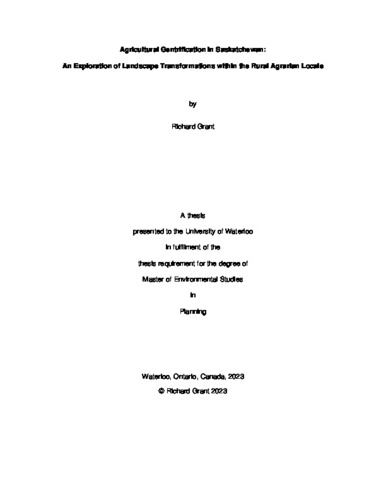| dc.contributor.author | Grant, Richard | |
| dc.date.accessioned | 2023-10-05 17:55:41 (GMT) | |
| dc.date.available | 2023-10-05 17:55:41 (GMT) | |
| dc.date.issued | 2023-10-05 | |
| dc.date.submitted | 2023-08-15 | |
| dc.identifier.uri | http://hdl.handle.net/10012/20027 | |
| dc.description.abstract | Due to the gradual shift from productivist-oriented activities, towards more multifunctional activities, landscape transformations are more visibly noticed within rural communities. The growing transition towards post-productive agricultural land uses raises questions about the future use of rural land in the face of sustainably developing rural communities. More importantly, it begs the question of how land use planners can fairly contextualize the nature of growth in rural communities while reacting to the different facets of gentrification.
Within gentrification research, there is a heavy focus on urban gentrification. More importantly, of the gentrification research conducted in rural communities, there is little focus on gentrification within the agricultural locale. The objective of my research is to examine the role that agricultural gentrification plays in facilitating landscape transformations in rural communities in Saskatchewan. My research looked at the agricultural restructuring occurring in rural Saskatchewan communities as a precondition of agricultural gentrification. Using a case study approach, three municipalities were selected to explore the phenomena of agricultural gentrification in Saskatchewan.
My research found that the province of Saskatchewan operates under an agro-industrial paradigm that utilizes a productivist-oriented form of farming as a means of determining the highest and best use of farmland. Three case studies selected to explore the relationship between landscape transformation and the emergence of agricultural gentrification utilized Neil Smith’s Rent Gap theory as a means of interpreting the gap between the farmland sale price and farmland value. The rent gap represented in the ratio studies of the three municipalities reflects the disparity between the farmland value and the corresponding farmland sale price. The value of farmland under this framework views the productive capacity as the highest and best use, which translates to its "value", and ultimately influences the sale price. The disparity between the farmland sale price and its value reflects how the “highest and best use of” farmland is determined under an agro-industrial paradigm in Saskatchewan. More importantly, the emergence of agricultural gentrification and its impact on the price of farmland has far reaching effects on land use decisions and rural community development. | en |
| dc.language.iso | en | en |
| dc.publisher | University of Waterloo | en |
| dc.subject | rural gentrification | en |
| dc.subject | rural development | en |
| dc.subject | landscape transformations | en |
| dc.title | Agricultural Gentrification in Saskatchewan: An Exploration of Landscape Transformations within the Rural Agrarian Locale | en |
| dc.type | Master Thesis | en |
| dc.pending | false | |
| uws-etd.degree.department | School of Planning | en |
| uws-etd.degree.discipline | Planning | en |
| uws-etd.degree.grantor | University of Waterloo | en |
| uws-etd.degree | Master of Environmental Studies | en |
| uws-etd.embargo.terms | 0 | en |
| uws.contributor.advisor | Pittman, Jeremy | |
| uws.contributor.affiliation1 | Faculty of Environment | en |
| uws.published.city | Waterloo | en |
| uws.published.country | Canada | en |
| uws.published.province | Ontario | en |
| uws.typeOfResource | Text | en |
| uws.peerReviewStatus | Unreviewed | en |
| uws.scholarLevel | Graduate | en |

